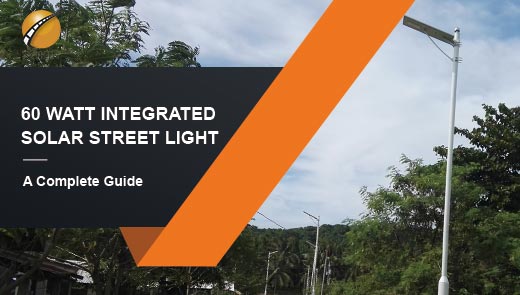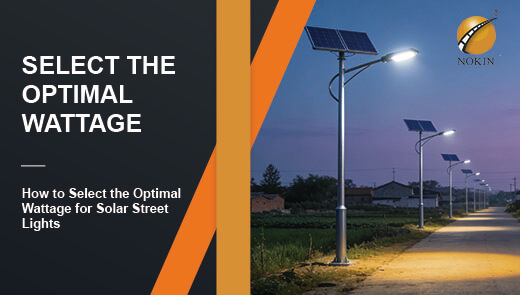Why IP67 Waterproof Rating Matters in Solar Street Lights?
Outdoor solar street lights are exposed to natural environments all year round, and have to face multiple challenges such as heavy rain, sand, dust, snow and even short-term waterlogging. Once these environmental factors intrude into the lamps and lanterns, it may lead to component damage and lamp failure, which will not only increase the maintenance cost, but also make the initial investment wasted. The IP67 waterproof rating is the “shield” for solar streetlights to cope with these challenges. It guarantees the durability, reliability and long-term performance of streetlights in harsh conditions. In this article, we will explain in detail what the IP67 rating means, how to enhance the durability of the lamps, as well as the key considerations during installation and maintenance.
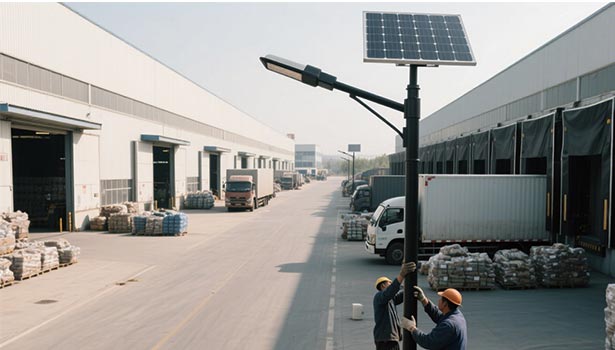
What is an IP Rating?
The Core Role of an IP Rating
IP (Ingress Protection) is a measure of a device's ability to resist intrusion by solids (e.g., dust, debris) and liquids (e.g., water, moisture). It is a rating that ensures that the enclosure of a device protects the components inside from foreign objects that could cause damage, malfunction or safety risks. In the case of a luminaire, the IP rating directly determines its suitability for a particular environment. For example, an indoor luminaire may only need basic protection, while an outdoor luminaire must be able to cope with rain, dust, etc. Otherwise, it is very susceptible to short-circuiting, brightness degradation and other problems.
Why is IP Rating Indispensable for Outdoor Solar Street Lights?
The core components of solar street lights - solar panels, batteries, LED light sources, etc. - are extremely sensitive to water and dust. Rainwater infiltration may lead to short circuit and burn out the lamps directly. Dust accumulation on the surface of the solar panel will reduce the power generation efficiency, some data show that when the thickness of the accumulated dust reaches 0.5mm, the power generation efficiency can be reduced by more than 20%, and the accumulation of internal heat dissipation channels may be blocked, triggering overheating of the components.
Long-term humidity will also accelerate the corrosion of metal parts, such as terminals and other key parts of the corrosion will lead to poor contact, seriously shortening the life of the lamp. Once these problems occur, it will not only affect the lighting effect, but also significantly increase the frequency of maintenance. Therefore, IP rating is the “basic threshold” of outdoor solar street light, without the appropriate protection level, even the most advanced technology can't play a role.
What Does IP67 Waterproof Rating Mean for Solar Street Lights?
Understanding IP67 Protection
The IP67 rating consists of two numbers that represent protection against solids and liquids respectively. The number “6” indicates total protection against dust, meaning that the luminaire's housing is completely impervious to dust and the internal components remain clean even after prolonged exposure to sand and dust. The number “7” indicates short-term immersion protection, which means that the luminaire can be immersed in water up to 1 meter deep for 30 minutes without water ingress, which is sufficient to cope with common outdoor scenarios such as heavy rainfalls and standing water from melting snow.
Benefits of IP67-Rated Solar Street Lights
In outdoor environments, solar street lights don't need to be waterproof to the depths of the ocean, but they must be able to cope with daily rain, short-term waterlogging, etc. IP67 balances protection with practicality: it can withstand more than 99% of the risks of common outdoor water and dust, but doesn't add cost and weight due to over-protection. IP67 is a perfect balance between protection and practicality.
IP67 protection for solar street lights is strong enough to cover rainstorms after the morning rush hour on city roads, muddy water on country roads during the rainy season, and morning dew on green belts in parks. This “just right” protection design avoids the waste of materials caused by the pursuit of higher levels, and does not leave hidden faults due to insufficient protection, which is fully suitable for the actual needs of most outdoor scenes.
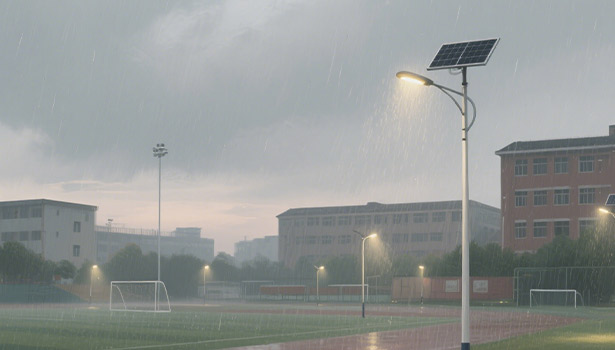
How Does IP67 Protection Enhance the Durability of Solar Street Lights?
Impact of Weather Resistance on Lifespan
The IP67 rating reduces "weather damage by ". Protecting against rain prevents deadly failures such as shorted circuits and leaking batteries. It is important to realize that when rainwater penetrates an electrical circuit, short circuits are repaired less than 30% of the time, and most parts need to be replaced outright. Anti-humidity can reduce the corrosion rate of metal parts, such as terminals and other critical parts, wet environment will accelerate the corrosion rate of 3-5 times, IP67 can significantly slow down this process.
Protection from dust maintains the efficiency of solar panels, with clean surfaces generating 10-20% more power while avoiding poor heat dissipation caused by internal dust buildup. These protections directly reduce “unnatural wear and tear” and bring luminaire life closer to the theoretical design value (5-10 years) rather than premature environmental obsolescence.
Protection Against Environmental Contaminants
In addition to water and dust, the IP67 rating blocks other common contaminants. In coastal areas, it protects against salt spray, which is highly corrosive, and the sealed construction prevents it from attacking metal parts - corrosion that can cause a bracket to fracture within six months in an unprotected state. In industrial areas, it prevents fumes and chemical dust from adhering to the LED light source, leading to brightness degradation (experiments have shown that unprotected fixtures can lose more than 30% of their brightness in six months). It also prevents small insects and leaf debris from entering the luminaire and blocking the vents or entangling the circuitry. In more polluted areas, IP67-rated solar streetlights have a 2-3 times longer “health cycle” than ordinary streetlights.
Long-term Cost Savings and Maintenance Benefits
The economics of choosing an IP67-rated solar streetlight are manifold. Reduced replacement costs, no need to replace lamps in advance due to water ingress, dust accumulation, etc. (the replacement cost of a single lamp is about 30%-50% of the initial investment). Reduced labor costs, less maintenance, saving inspection and repair labor costs. Stable power generation, solar panel efficiency is not affected by dust, ensuring sufficient power supply, especially for off-grid solar street lights, stable power generation means guaranteed lighting time. Take a municipal project with 100 streetlights as an example: the total investment (including maintenance) of IP67 grade streetlights for 10 years is 30%-40% lower than that of low protection grade streetlights, and it can avoid the dark light problem caused by frequent failures, which reduces the hidden danger of public safety.
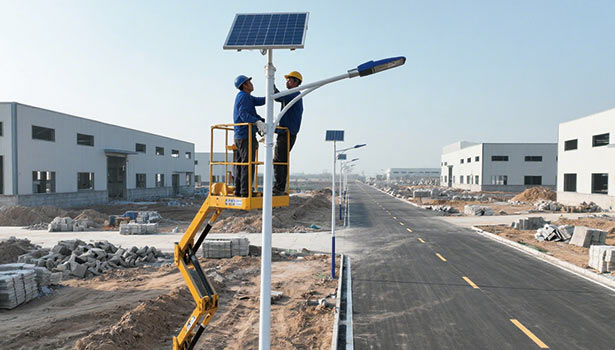
What Are the Installation Considerations for IP67-Rated Solar Street Lights?
Proper Mounting and Sealing Techniques
IP67-rated protection requires proper installation, and the key considerations are as follows. Strictly according to the instructions to seal the interface, solar panels and the main body of the light, the battery compartment and the shell of the connection parts, you need to use the matching sealing ring or silicone, tighten the strength of the uniform (too loose sealing is not tight, too tight may be pressed to break the rubber ring). Avoid opening holes privately, if you need to thread, you need to use a special waterproof connector, prohibit direct drilling, the holes will become a channel for water intake. Fixed firmly, when installed in typhoon, strong wind area, need to reinforce the connection between the light pole and the lamps and lanterns, to prevent the vibration caused by the sealing part of the loosening.
Considerations for Different Environmental Conditions
Different environments require an installation strategy that takes into account the characteristics of the IP67 rating. In coastal areas, the poles and metal parts should be made of salt spray-proof materials (e.g. 316 stainless steel), and the joints should be coated with antirust oil regularly to further enhance the resistance to salt spray corrosion. In dusty areas, the tilt angle of the solar panel can be adjusted to 30°-45° to utilize natural rainfall to wash away surface dust and reduce the frequency of manual cleaning. In high-temperature areas, avoid installing the lamps directly near heat sources such as factory smoke vents, and reserve enough space for heat dissipation to prevent high temperatures from affecting the life of seals. In cooler temperatures, insulation can be added to the outside of the battery compartment - the IP67 sealing will not affect the insulation, and the lack of water inside prevents damage to components from freezing and expanding.
Maintenance and Inspection Protocols
Even with an IP67 rating, routine maintenance is required to maintain the effectiveness of your solar street light. Monthly inspection, check whether there are cracks in the lamp shell, whether the interface is loosened, and repair the problems in time. Quarterly cleaning, use a soft cloth to wipe the surface of the solar panel, avoid using high pressure water gun to prevent water pressure from breaking the seal. Professional maintenance, if you need to open the battery compartment or replace parts, must be operated by professional personnel -- After maintenance need to re-check the sealing performance, can be a simple drenching test, to observe whether water ingress. Seal replacement, rubber ring, sealant and other wear parts should be replaced every 2-3 years (sealing performance will be reduced after aging).
For solar street lights, the IP67 rating is not an additional feature, but a basic guarantee - it can withstand rain, dust and other environmental threats to ensure that the lamps and lanterns work stably in a variety of outdoor scenarios. It prolongs life, reduces maintenance and lowers long-term costs. What's more, it can avoid dark light problems caused by malfunction and protect public safety. Whether for municipal procurement, park construction or rural transformation, choosing IP67-rated solar street lights is an investment in “long-term value”. After all, a street light that stays on through thick and thin is a truly meaningful lighting facility.

